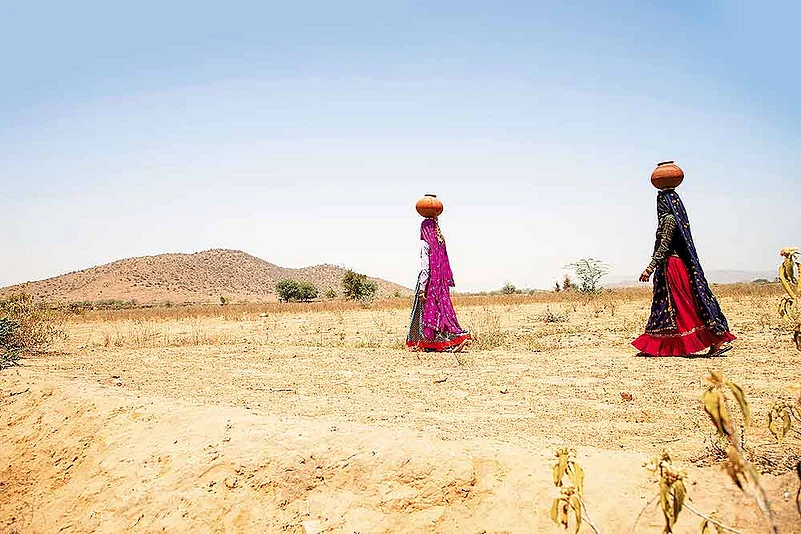When it comes to health and emotional issues related to women and girls, especially adolescent girls, in rural India, there is a culture of silence and shame. There is also a tendency to not give it enough importance or priority in a generally male-centric society in which women are supposed to prioritize the needs and requirements of the men-folk, or their elders over themselves. In such an environment, thinking about oneself is considered to be a matter of selfishness, or an individual with loose and non-traditional morals. Hence, there is social conspiracy of silence in rural India around issues such as menstruation, safe sex and STDs, abortion, and other sexual and reproductive health issues.
“I used to write down questions regarding my periods, and leave them for my mother, because I was too embarrassed and scared to speak to her directly,” shares an adolescent girl living in a city. Even if girls do have the courage to talk to their elders, and this is rare, often there is no access to the vocabulary to describe what is happening with the body of a growing-up girl. Such matters are never discussed, and there is no active encouragement to do so. Hence, there is a lack of physical, mental, and psychological spaces for the girls and women.
Still, there is no doubt that there is progress of sorts. Large proportions of women do use sanitary pads and napkins across Indian cities, towns, and villages. Mainstream movies, and other modes of popular culture, have highlighted the naturality of menstruation and sex, and encouraged women to use modern products. But there is a huge population in rural India, which still uses cloth, or nothing at all because of the lack of information and communication. Even among those, who use pads and napkins, their disposal is a huge issue.

Over the past several decades, central and state governments, as well as civil society, launched mass campaigns and advocacy to encourage the use of sanitary pads. In cities, there is a significant shift towards bio-degradable pads or organic ones so that disposablity isn’t a problem. Subsidies and other modes have nudged women and girls to use pads in the villages. But it is a long road ahead. There is much that needs to be done, that has to be done.
However, experts now realize that public health communication is not a matter of ‘push’, i.e. force people to take the necessary and corrective steps. In effect, the goal is to inculcate behavior change within communities and households, and within the society, so that it leads to long-lasting and sustainable transformation. The idea is to change the mindset, and make the use of certain products as a matter of habit and routine. Such a process requires a sensitivity and consciousness about the local context, on-ground realities, and traditional thoughts. It needs to understand how to use local and existing knowledge and behavior to make the conditions better. It is imperative to use local languages and idioms to make the information and social messages accessible and relevant.
This is one of the biggest learning for several reasearchers, social workers, and NGOs, who work in the rural areas. One such research in three Hindi-speaking states of Bihar, Uttar Pradesh, and Jharkhand aimed to recognize and document the gaps in social health messaging and communication. Through formal interviews and discussions with hundreds of girls and women in dozens of villages, the study found several gaps and challenges. The situation wasn’t as good as one thought, and only when one struck a rapport with the girls and women did they openly discuss their fears, apprehensions, anxieties, and emotional needs.
Despite the hype around TV and mobile revolution — most Indians have a mobile, it is said — rural women have limited access to media or different sources of information. The men or the elders control the phone, and communication, so to say, compared to the younger women and girls. The latter can use the mobile, or even watch TV, only under the shadow of their parents, husbands, and other elders. Thus, information hardly circulates among the women. If it does, it is by default, and not because of active interventions.
Clearly, there is a pool of traditional and local knowledge, but this too is not always shared because of social stigma attached to several subjects. The information and communication gaps logically lead to an atmosphere of shame, silence, and stigma, especially among the younger generation. Thus, myths and superstitions around menstruation, and other subjects, thrive. Girls, who have inconsistent or late periods, are taken to quacks who charge as much as Rs 10,000 each for the so-called treatments. This is part of the truth about public health.

Often the understanding of the female, or the gender differences, is reduced to the physical needs of women. These needs, in turn, are seen only from the perspective of sex and reproductive health. There is no desire or understanding within the communities to explore mental and emotional needs such as desire for the opposite sex, violence within families and marriages, need to communicate and express, and gender attraction. Hence, there is a huge chasm as far as the women experiences of gender and sexuality are concerned.
Take the example of the women who, knowingly or knowingly, go through marital rape. Their experiences, as several studies found, were quite dismal. Marital rape is an experience that is shrouded and veiled because most women don’t believe they have a say in whether or not to engage in intercourses with their husbands. They think that they need to go to bed with them as and when the latter demand it or force themselves on the wives. When some researchers worked with local community radio stations, and devised specific health content for them, they discovered some encouraging stories. One woman, who heard the program on marital rape, realized her rights. The next time her husband forced sex on her, she said no. Although this was unheard of, since men assume that they make their women enjoy sex, it led to a new reality. It helped open a window for discussion between the partners.
During visits to several villages to narrow-cast the same program, the researchers met the woman, who told them her story. She openly approached the researchers and proudly described what she had done. She added that after she had the conversations with her husband, he asks her each time he wants to have intercourse. Fortunately, their relationship became less irritable, and happier. There is also the fact that she now enjoys the sex and physical intimacy more than before, because she is an active partner.
But such encouraging stories are interspersed with others, including a few amusing ones. For example, a girl in one of the villages confided that the government’s construction of toilets has provided her and her friends with a unique emotional and physical escape. The excuse to go to the toilet is now used as an alibi to clandestinely meet with her boyfriend. There is a new romance in the age of toilets. More importantly, going to the toilet, in fact, is her only escape from the moral gaze of her family members. The toilet has led to an emotional release.
Given the mindset to keep the toilet further away from the house leads to more difficulties, rather than a convenience. For many women, the journey to the toilet is treacherous and, apart from the fear of the dark, there is the fear of violence and harassment. In fact, several girls and women confided that they deliberately skip their dinners, even don’t drink water in the night, so that they are not forced to venture out to the toilets in the dark. More importantly, they don’t inform their parents or husbands, or talk about such issues because of fear and embarrassment. The toilet is both a boon and a bane in several villages.
Sadly, there are other examples, which prove that in a large country like India, one cannot pursue a policy of one-size-fits-all. So, while the construction of toilets was noble and much required, local context and mindset needs to be taken into account. In several villages, the money allocated for the toilets was used in other activities, like marriages and festivals. In places, where the toilets existed, they were not in use. Several women admitted that they were not aware about the health and social benefits of toilets. In different states, and among different communities, subjective accounts yielded varying understanding among households, communities, and gender on what ostensibly seems to be a matter of the construction of health-related infrastructure. The use of it wasn’t a part of it.
Questions of access and development cannot be addressed without a thorough understanding of cultural contexts, attitudes and beliefs. The arrival of a new object, even something as innocuous as a toilet, can cause ripples and disturbance in the organization of social life. The intention of a behavior change communication initiative cannot be to push for the construction of toilets. It has to first, or at least simultaneously, encourage discussion between family members in the households, draw attention to health-related repercussions within communities, and remove the stigma around public health.
The stakeholders and policy makers have to engage with local beliefs in several parts of rural India — that neither a kitchen nor toilet can be inside the house; the latter needs to be located far away. They cannot be dismissed or wished away; toilets cannot be imposed upon them. Unless the communication changes, as can be witnessed in several parts, the construction and creation of health infrastructure does not necessarily and compulsorily lead to actual use. ‘Nudge’ economics, rather than forced socio-economic schemes, is crucial. People need to be cajoled towards social transformation. One has to sensitive the communities and households to the intricacies and inter-connectedness of the various issues.
Consider another example. In one of the villages in Jharkhand, most women preferred home deliveries, and didn’t wish to go to the hospitals for various reasons. In this case, the hospital was located 10 km away, required a long journey, and the clinical and impersonal atmosphere, as well as behavior of the doctors and other personnel, deterred and intimidated the women. There was also a prevailing distrust of the medical system, which most women felt was exploitative and expensive. In contrast, midwifery was a more comfortable, secure and an affordable option.
In addition, most ASHA workers, which form the basic foundation of the country’s rural public health system today, didn’t visit this village more than once a month, and that too usually for cursory health check-ups. The village was located four km away from the nearest public health centre. The relationship between the ASHA workers and community members was strained because many local women held a grouse against the former for not making regular visits. Thus, a system to benefit the community broke down.
Clearly, opinions and assumptions about health are shaped by cultural contexts. Fears and anxieties lead to the formation of social myths that are difficult to break. For example, pregnant women don’t eat well because of the fear that if the child is above a certain weight, an unaffordable surgery is required. These anxieties are usually hidden, and never spoken about. This is the public health logjam that needs to be broken. Communication has to focus on local sub-texts.
- In several regions, women prefer home deliveries because of the ease and comfort
- Pregnant women don’t eat well to avoid expensive surgeries
- Physical structures don’t logically lead to their usage; toilets need water


























